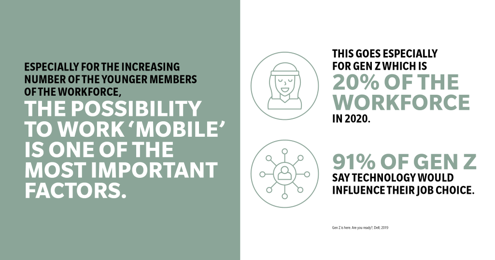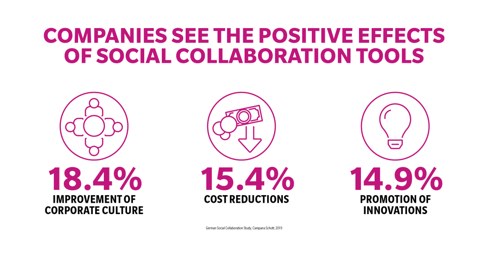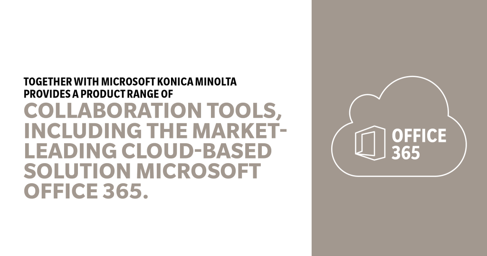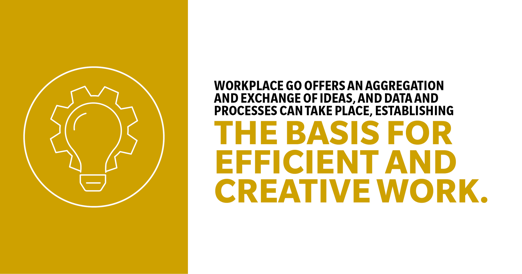The way we work in a professional environment has fundamentally changed in the past years. It has seen the rise of a new star: collaboration. The share of the total working time that full-time office workers spend in virtual or digital collaboration has doubled in less than a decade from a mere 7% in 2013 to 14% in 2019.[1]Ever more workflows and processes are built around interconnected teams. This is because working in diverse, specialised and well-connected teams is a key success factor today. This style of working is becoming increasingly important, specially for small and medium-sized businesses (SMEs). Digital infrastructure and solutions are the backbone of this development. Additionally, working together within often geographically distributed teams is not just an expectation that businesses have of their employees - it increasingly is what employees demand of their employers: today’s mobile workforce sees this as a given. They therefore have high standards in their perception of ideal collaboration and the tools needed for it. Statistics show that today only 35% of workers prefer working from their regular office desk, whereas 65% describe other spaces such as their home, public spaces or a ‘hot desk’ in the office as their optimal working environment.[2]Hence, the market growth for the field of cognitive collaboration technology is expected to rise by 11% every year, reaching USD 1,660 million by 2024 from USD 983 million in 2019.[3]For the majority of organisations the task of providing their employees with the necessary solutions to enable this type work environment is often difficult for them to stem alone. However, there are various ways to take advantage of this way of working without having to place an additional burden on IT departments or their budgets. This is particularly the case when implementing solutions like Microsoft Office 365 or Workplace Go from Konica Minolta together with a trusted supplier.
What teams need to function at their best

“SMEs today need to facilitate productive interaction within variable teams in the most effective ways possible,” explains Michal Sommer, ITS Business Development Manager, Konica Minolta Business Solutions Czech spol. s.r.o. “The scarcity of skilled professionals and the geographical diversity of locations together with rising expectations about technology require systems that make collaboration effortless and seamless.” With their number increasing steadily, especially for the younger members of the workforce, the possibility to work ‘mobile’ is one of the most important factors. Gen Z accounts for 20% of the workforce in 2020 and 91% of them will be influenced by the technology and how they are able to use it when it comes to their job choice.[4] On top of that, the Institute for Corporate Productivity and Rob Cross, Professor for Global Business at Babson College, found that companies promoting collaborative working were five times as likely to be high performing. According to the research with more than 1,100 participating companies, the purposeful pursuit of collaboration is the primary reason why high-performance organisations achieve their desired business outcomes.

Thus, effective collaboration drives productivity and gives companies in competitive markets a critical, leading edge.[5] No matter if working together with external experts on a short-term task force or on a long-term basis with internal colleagues across different company units, processes and the corresponding technology to run them have to be capable of bringing people and their work together. Both software and hardware have a more decisive role within daily working environments than ever before. The interplay of devices and applications are what really makes the difference in speed and level of how productive teams as a whole perform. Many decision makers see the positive effects of social collaboration tools, which is why they increasingly want to implement them. Research conducted by Campana Schott found that the most important factors here are a positive effect on corporate culture at 18.4%, cost reduction at 15.4% and the promotion of innovation at 14.9%.[6]
Digital collaboration: addressing the challenges SMEs face
However, one of the most important questions in this context is how well collaboration is facilitated by the existing corporate IT environment in SMEs today. “It is very important to have implemented systems that are capable of providing a holistic solution for workplace productivity and all necessary functionalities with collaboration already built into the platform,” Michal Sommer at Konica Minolta explains. “Having to deal with an opaque tangle of semi- or non-compatible legacy systems, where an additional layer of collaboration software has to be added on top, can have very negative consequences for the collaborative user experience and the efficiency of the system itself,” he adds. Especially for small and medium-sized businesses, taking on the creation of such a digital collaborative environment for their workers by themselves entails big challenges: the main topics to be considered here are the potential costs and the resources needed. Businesses also require a scalable and flexible solution fitting their IT’s capabilities without being limited by them.
Strong partners to meet the challenge of seamless collaboration

Strong partners are indispensable in order to achieve such a working environment. Addressing this, Konica Minolta is cooperating with other leaders in office productivity to offer its customers strong holistic solutions for a wide range of modern collaboration applications that are implemented and adjusted based on customer needs. Together with Microsoft, for example, Konica Minolta provides a product range of collaboration tools, including the market-leading cloud-based solution Microsoft Office 365. This solution empowers users with helpful tools such as Teams, Yammer, SharePoint or OneDrive.
For good reason, Microsoft Teams is increasingly becoming the collaboration tool of choice for many businesses. It is a unified platform for communication and collaboration that reduces complexity and enables employees to easily interact with each other. Microsoft Teams lets them set up dedicated project teams for borderless collaboration while combining constant workplace chat, file storage and video meetings. All of this happens seamlessly with full integration of the Microsoft Office 365 applications that they are already familiar with such as Word, PowerPoint and Excel into Teams.
As a social network for sharing information and connecting people within organisations, Yammer is also increasingly finding its place in businesses of all sizes. It is an ideal tool to connect experts internally and share valuable insights. In addition, the collaborative platform SharePoint allows for easy document management and sharing. Just like in OneDrive for Business, which is a file hosting and synchronization service, SharePoint lets users share versions and synchronise files and documents with colleagues. However, SharePoint is much more than that: entire team websites with discussion groups, blogs, wikis, calendars, task lists and much more can be created - while OneDrive is limited to document storage, universal access and version management.
“Microsoft Office 365 with its applications empowers customers to work as they need to today – interconnected with the highest flexibility and exchange possibilities for their teams in an intuitive and secure virtual collaborative environment,” Konica Minolta’s ITS Business Development Manager sums up. Konica Minolta therefore offers integrated IT service solutions that include the full range of Office 365 applications with all their benefits. Accessing the cloud-based application from outside the organisation is seamless, and the smart security systems adapt to the changing environment and require two-factor-authentication or conditional access. Microsoft’s office solutions therefore ensure a high level of security as well, since they protect every file individually.
Integrating collaboration into holistic IT environments
Konica Minolta also offers an even more holistic approach to IT in order to take its customers a step further. It can seamlessly integrate all the collaboration tools a business needs: an all-in-one edge IT platform such as Workplace Hub, which provides the ideal basis for SMEs. The ultimate goal is to free up and unburden internal IT professionals in their work and enable organisations to reduce cost factors through SaaS.

With Workplace Go, Konica Minolta offers a collaboration solution that unifies Microsoft Office 365 functionalities within one user interface. Users do not have to log into each application separately, but have the functionalities of Office 365 available right at their fingertips. Workplace Go offers functionalities such as communication handling, collaboration, social networking, productivity and an intranet feature. This solution is an easily configurable, browser-based digital workplace that is available from anywhere, anytime and on any device. As such, it is able to deliver all the information and tools employees need to perform better and organise their information, especially – but not exclusively – when working in a team. Therefore, Workplace Go offers an aggregation and exchange of ideas, and data and processes can take place, establishing the basis for efficient and creative work. As especially smaller companies often struggle with poor IT expertise and limited budgets, Workplace Go is offered – in the first instance – with two ready-to-deploy templates with branding options. What is more, mid-sized and larger organisations can take advantage of the many custom design possibilities of Workplace Go depending on their specific needs and demands. Workplace Go can either be purchased together with Workplace Hub or as a standalone solution.
Knowing the benefits of digital collaboration tools – from its own experience
“As an IT solution provider, we offer a wide variety of services especially when it comes to the software area. We are a global organisation ourselves and therefore know the complexities of mobile work and modern collaboration,” explains Michal Sommer at Konica Minolta. “Konica Minolta is well-known for adopting new work styles since the early stages of the reform movement, and we are therefore always eager to implement new technology and software solutions that foster collaboration in our own organisation as well.” Connected to this process, the work-style reforms are aimed at making it possible to perform creative work anywhere by enabling a diverse range of people to work in a variety of styles. To achieve this goal, Konica Minolta needed to make significant changes to the structure of its communication platform. “Our teams therefore perfectly know the every-day implications and benefits of collaborative working with Microsoft Office 365 and Workplace Go and the related applications from first-hand experience. We share this experience together with the expertise to set up such a solution with our customers of all business sizes,” Michal Sommer says. This is combined with Konica Minolta’s customer-centric business approach to finding the exact collaboration solution the customer needs.
Best practice examples
Konica Minolta implemented Microsoft Office 365 for its customer Elajo, one of Sweden’s leading electricity, mechanical engineering and energy companies. Konica Minolta harmonised the company’s office software by implementating Microsoft Office 365 across all of the customer’s locations and their mobile devices. The solution provides a wide range of applications for mobile and remote work as well as communication for Elajo’s employees, who are constantly on the road or at construction sites. Access to new applications provides employees with greater flexibility in how they work and how they interact with their peers. “This ensures the team members can work together freely. Our focus in supporting our customers with exactly the solutions they need is what truly sets Konica Minolta apart as a partner for collaboration solutions”, complements Michal Sommer from Konica Minolta. Another example of successful implementation of Workplace Go is the French manufacturer of insulating glass Le Kap Verre. As an element of the Workplace Hub, it brings together work processes and data in one place. It offers the company an environment that supports its digital transformation and increases the efficiency of their highly mobile teams in need of the right information at the same time. This enables them to work under optimum conditions.
Break down boundaries with Konica Minolta’s tools for digital collaboration
Effective collaboration is a very important state which is taken for granted far too easily, especially in larger organisations. However, many smaller and medium-sized business struggle to overcome the obstacles to technologically supporting team collaboration as they should. The sheer flood of data and information paired with the high number of different tasks result in unstructured ways of working. This makes it even harder to coordinate teams. Work progress can come to a halt due to unclear priorities, varying levels of knowledge among peers and an inability to receive timely and accurate status information. Therefore, a viable set of digital collaboration solutions provided by a strong partner like Konica Minolta are the key for the future of modern teamwork. With its holistic customer-centric approach towards IT, Konica Minolta helps to make working together with colleagues – particularly when they are operating from different locations – effortless and hence helps to relieve stresses which would add to already high workloads.
- U.S. Workplace Survey; Gensler Research Institute; 2019
- The Avast Business 2018 Mobile Workforce Report; Avast; 2018
- Collaboration Market - Global Forecast to 2024; Research and Markets Cognitive; 2019
- Gen Z: The future has arrived; Dell Technologies; 2018
- Top Employers are 5.5x more likely to reward collaboration; Institute for Corporate Productivity (i4cp) and Rob Cross, Edward A. Madden Professor of Global Business at Babson College; 2017
- German Social Collaboration Study; Campana Schott; 2019



